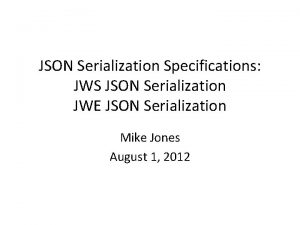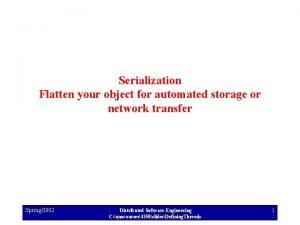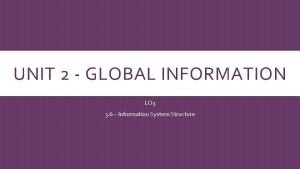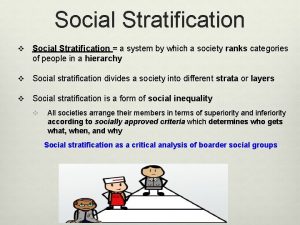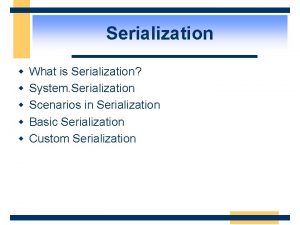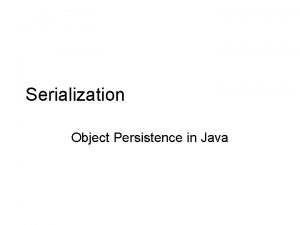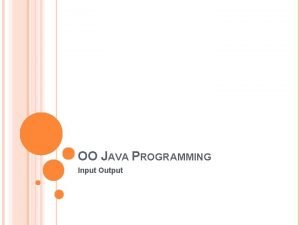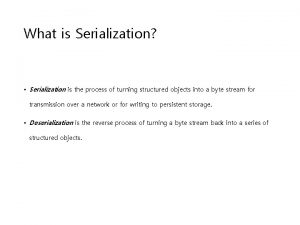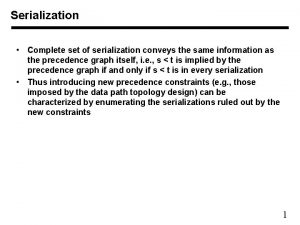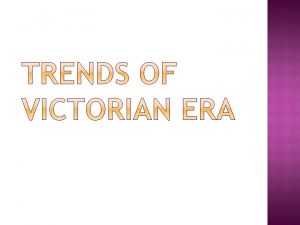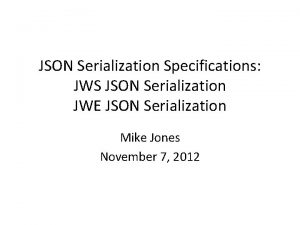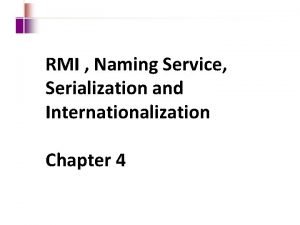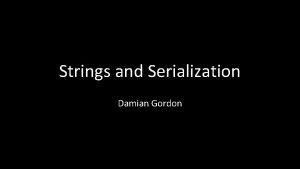Serialization w w w What is Serialization System





![Serializaiton File. Stream Example class Serialize. Example{ public static void Main(String[] args) { Array. Serializaiton File. Stream Example class Serialize. Example{ public static void Main(String[] args) { Array.](https://slidetodoc.com/presentation_image_h2/835356ab1116d801803c28c930c045ff/image-6.jpg)











- Slides: 17

Serialization w w w What is Serialization? System. Serialization Scenarios in Serialization Basic Serialization Custom Serialization

Serialization/Deserialization Object in memory …binary or character stream… Object in memory

Serialization What is Serialization w Serialization is the process of converting an object, or a connected graph of objects, stored within computer memory, into a linear sequence of bytes w Use the sequence of bytes in several ways: n n Send it to another process Send it to the clipboard, to be browsed or used by another application Send it to another machine Send it to a file on disk

Serialization Object Graph w What is an object graph? n n An object graph is a set of objects with some set of references to each other The most obvious problem is how to represent the links between the objects in the Serialized stream 3 4 Cat Dog Cat 7 9 1 Horse Mouse 2 Duck

Serialization How Serialization Works w Because run-time metadata 'knows' about each object's layout in memory, and its field and property definitions, you can serialize objects automatically, without having to write code to serialize each field w The serialized stream might be encoded using XML, or a compact binary representation w The format is decided by the Formatter object that you call: n n n Binary SOAP Custom
![Serializaiton File Stream Example class Serialize Example public static void MainString args Array Serializaiton File. Stream Example class Serialize. Example{ public static void Main(String[] args) { Array.](https://slidetodoc.com/presentation_image_h2/835356ab1116d801803c28c930c045ff/image-6.jpg)
Serializaiton File. Stream Example class Serialize. Example{ public static void Main(String[] args) { Array. List l = new Array. List(); for (int x=0; x< 100; x++) { l. Add (x); } // create the object graph File. Stream s = File. Create("foo. bin"); // create the filestream Binary. Formatter b = new Binary. Formatter(); // create the Binary. Formatter b. Serialize(s, l); // serialize the graph to the stream } // end main } // end class

Serializaiton Deserialize Example using System; using System. IO; System. Collections; System. Serialization. Formatters. Binary; class De. Serialize { public static void Main(String[] args) { File. Stream s = File. Open("foo. bin"); // open the filestream Binary. Formatter b = new Binary. Formatter(); // create the formatter Array. List p = (Array. List) b. Deserialize(s); // deserialize p. To. String(); // print out the new object graph } // end Main } // end Class De. Serialize

Serialization Basic Serialization w A Type is NOT Serializable unless Type is specifically marked as Serializable w The Serializable Attribute [Serializable] public class My. Class {} w The Non-Serializable Attribute [Serializable] public class My. Class { [Not. Serialized] int _cash. Size; }

. NET Serialization Facilities Take an extremely simple C# class: public class Initial. Configuration { public enum Difficulty {hard, medium, easy}; public Initial. Configuration() { } public Difficulty starting = Difficulty. medium; }

. NET Serialization Facilities Use. NET library functions to serialize it: Initial. Configuration conf = new Initial. Configuration(); Xml. Serializer ser = new Xml. Serializer(typeof(Initial. Configuration)); Xml. Text. Writer writer = new Xml. Text. Writer( stream, System. Text. Encoding. UTF 8); ser. Serialize(writer, conf);

. NET Serialization Facilities Get XML: <? xml version="1. 0" encoding=“utf-8"? > <Initial. Configuration xmlns: xsd="http: //www. w 3. org/2001/XMLSchema" xmlns: xsi="http: //www. w 3. org/2001/XMLSchema-instance"> <Starting>medium</starting> </Initial. Configuration>

Serialization Customize Serialization w Implementing ISerializable interface w IDeserialization. Event. Listener w Custom Formatters

Serialization ISerializable Interface w Customize the serialization process w If a class implements ISerializable, that interface will always be called in preference to default serialization. w The ISerializable interface is only contains one method: void Get. Object. Data (Serialization. Info info, Streaming. Context context); And an implied constructor that may be private <Type. Name> (Serialization. Info info, Streaming. Context)

Serialization IDeserialization. Event. Listener w If an object implements IDeserialization. Event. Listener, the serialization infrastructure will call that class‘ On. Deserialization method as soon as the entire graph has been deserialized and all fixups completed w Provide a reasonable opportunity for objects that need to do fix-ups based on the state of their children

Serialization Custom Formatter w Implementing IFormatter Interface: public interface IFormatter: { //Properties Serialization. Binder { get; set; } Streaming. Context { get; set; } ISurrogate. Selector { get; set; } //Methods object Deserialize(Stream serialization. Stream); void Serialize(Stream serialization. Stream, object graph); }

Conclusion w Types' metadata can be explored with Reflection w Reflection provides dynamic type system w The Federated Services Model is one of the core concepts for designing. NET applications in Internet w Key. NET Remoting scenarios are: n n Web Services Anywhere CLR Object Remoting w Serialization is the process of converting an object, or a connected graph of objects, stored within computer memory, into a linear sequence of bytes

Resources w http: //msdn. microsoft. com/net/ w. NET Framework SDK
 Sncm serialization
Sncm serialization Can't pickle psycopg2.extensions.connection objects
Can't pickle psycopg2.extensions.connection objects Kotlinx serialization optional
Kotlinx serialization optional Hadoop io
Hadoop io Network serialization
Network serialization Jws json serialization
Jws json serialization Dqsa timeline
Dqsa timeline Kotlinx serialization performance
Kotlinx serialization performance Is earth open or closed system
Is earth open or closed system Digestive system circulatory system and respiratory system
Digestive system circulatory system and respiratory system Caste system versus class system
Caste system versus class system Open vs closed system
Open vs closed system Presidential system of government
Presidential system of government Parliamentary system vs presidential system
Parliamentary system vs presidential system Figure of female reproductive system
Figure of female reproductive system Endocrine system and reproductive system
Endocrine system and reproductive system Tiny air sacs at the end of the bronchioles
Tiny air sacs at the end of the bronchioles Caste system versus class system
Caste system versus class system





